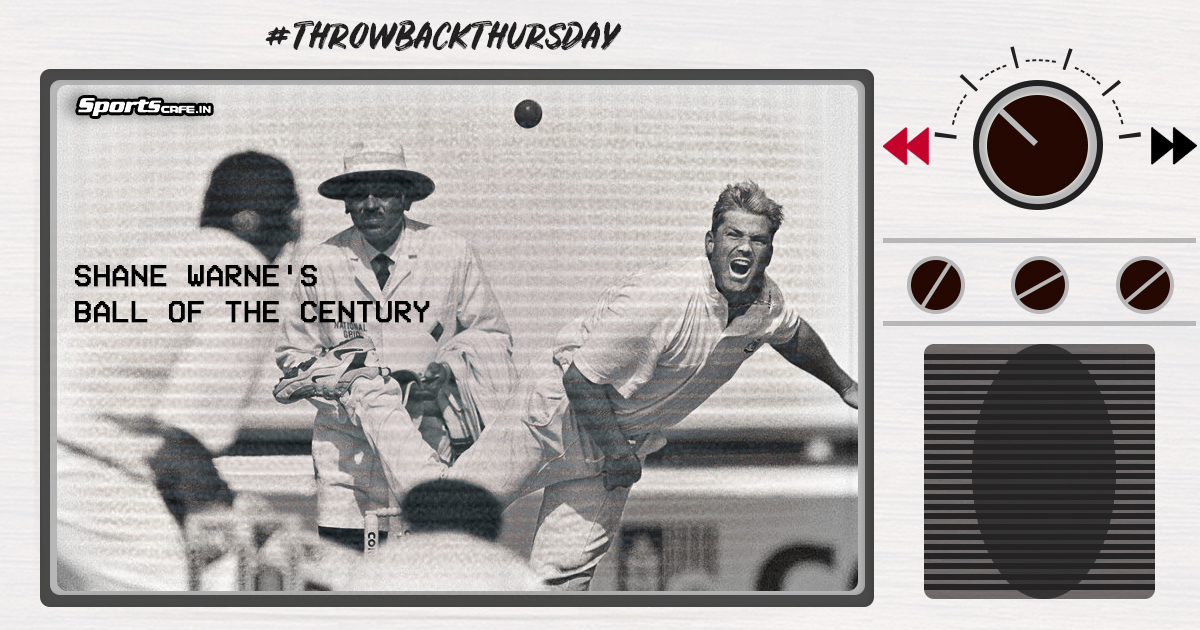Throwback Thursday | Shane Warne’s ball of the century

Welcome to a session where we unfold a moment from history that remains a significant part of the sport we love and is, perhaps, very close to our hearts. Here we unravel our weekly special segment ‘Throwback Thursday’, where we take a trip down memory lane and revisit the 'Ball of the century'.
This is June 4, 1993, and the Ashes, the greatest deemed rivalry in the history of cricket, is making its return for a new enthralling edition. Australia, who have put up a total of 289 in the 1st innings, are doing their best to contain their good-old rival England. Opening batsmen Mark Taylor and Michael Slater have scored a hundred and a half-century in the 1st innings of the 1st Test match in Manchester, which started a day ago on June 3, but the rest of the batting lineup tumbled down, thanks to a remarkable performance by debutant Peter Such. The 28-year-old off-spinner bagged six wickets, including captain Allan Border and Steve Waugh, in the 1st innings. The pacers, on the other hand, were rather unsuccessful and the onus was on a young Shane Warne to do the magic for Australia. But before we could unravel Warne's magic, it is important to take a detour and go back in time.
Leg spinner Warne didn’t have any significant First Class experience before entering the Test arena, in 1992, when India toured Australia. Warne had actually entered the international scene when legspin was a dying art. Yes, we would like to call it an art, as each and every element of the sport is. But, luckily for the Aussie, he had a cricketing inspiration to look back on. The 1980s were witness to the West Indies being the best team in the world. A team like Pakistan wasn’t even a competition. Clocking back to 1986, the mighty Windies had not lost a single Test series prior to the series against Pakistan. Apart from the two Tests, both to Australia in Australia, the Windies were unbeaten in 51 Tests out of 53 leading to the Pakistan tour. They had recorded 18 wins in 22 Tests in that era against Pakistan. Then came the first Test.
The same story unfolded as the mighty pace unit of the Windies, feared by all batsmen of the era, bowled Pakistan out for 159 at their home. However, in the proceedings of the said Test match, magic happened. The magic was of course caused by a human being named Abdul Qadir. His magic didn’t include card tricks or a bunny, but he did have something up his sleeve. That unusual thing up his sleeve helped him conjure a remarkable win for the hosts. And what do you know, the tourists had been bowled out for 53, their lowest score in history as Qadir bagged 6/16. In a time when the art of legspin was declared dead, Qadir, with the resurrection fern up his sleeve, brought back the magical element of cricket back to life.
Now coming back to the Ashes rivalry, which begun as early as 1882 when Australia defeated England at The Oval, the two teams involved were always playing it out like nothing else mattered. The term ‘The Ashes’ originated in a sarcastic obituary published in a British newspaper, The Sporting Times, to commemorate the death of England cricket as they lost to Australia for the first time on English soil. The obituary declared that English cricket had died, and "the body will be cremated and the ashes taken to Australia". Then on the English team was dead set to "regain those ashes". Consequently, a small urn then came into being during their next contest and has been known to be the ashes of a wooden bail, and was amusingly described as "the ashes of Australian cricket". Even though the urn was never the official trophy of the Ashes series, the replicas of the urn are now a symbol of victory in an Ashes series. It was also put on touring display as a part of the Australian Bicentenary celebrations in 1988.
Now coming back to the more recent times, just before Warne made his Test debut for Australia. In the late 1980s, the Australian team became as powerful as great teams of the past, which in 1989 defeated England 4–0 under captain Border. In fact, the ongoing series of 1993 was for Australia to “regain the Ashes” but how? The art of spin was already on the decline since the 1960s, and through 1980s to 1990s - when only about 31 per cent of the deliveries are bowled by spinners. And what Warne is offering is legspin, an art declared as almost dead. But it’s just moments before everything changes. However, the pitch at Manchester favoured spin bowling, as was seen in the performances of Phil Tufnell and debutant Peter Such. However, Australia went with three fast bowlers and an inexperienced Warne as the only spinner.
Australia have been bowled out for 289 and so far they have only claimed the wicket of opening batsman Mike Atherton, who was dismissed by the mighty Merv Hughes. For the urn to be regained, Australia had to resort to some kind of magic away from home. After all, a win in the first Test is always a good sign. It wasn’t until England were on 80/1 that Border brought in spin. But when he did, what was going to unfold next, on Day of the Manchester Test, was nothing but unforeseen magic.
We’re still in the 2nd innings of the Test and England are on 80/1. Captain Allan Border has summoned a young legspinner, with 31 wickets in his first 11 Tests, and the batsman he is going to bowl to is England’s No.3 Mike Gatting. New Zealand’s top batsman Martin Crowe was in awe of the untested Warne ahead of the series but what’s the place of a legspinner in a pace dominated game? And here the youngster is about to face one of the renowned batsmen in the game. Not too much was expected of him, and yet eyes of the Day 2 crowd at Old Trafford were set on him.
Warne starts off, after a discussion with his peers, with a slow run-up and bowls a classic leg-break to the right-handed batsman. The ball initially travells straight down the pitch towards the batsman and lands on the rough patch of the pitch. We’re microseconds away from a great reality that’s about to unfold. Let’s just say this delivery is going to be everything that matters.
Welcome to a moment in history
